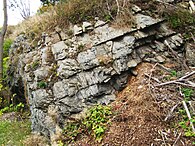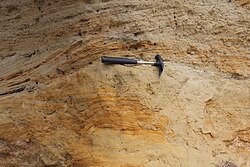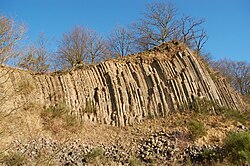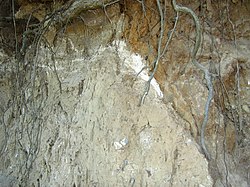Geology of Germany
The geology of Germany is significantly shaped by several phases of mountain formation in the Paleozoic and Cenozoic Era , by sedimentation in shallow seas and plains in the Permian and Mesozoic Era, and by the glaciations of the Quaternary Ice Age .
Regional geological framework and fundamentals
Germany is located between the geologically very old ( Precambrian ) Eastern European craton ( Baltica ) in the north and northeast, which is exposed further north as the Baltic Shield , and the geologically young ( Cenozoic ) Alps - Carpathian orrogen in the south. The corresponding crustal provinces are thus "middle-old" and were attached (accreted) to the Eastern European craton in the course of the Paleozoic Era through plate tectonic processes. They form what is known as the basement of Germany.
The basement is the oldest of the four geological "floors" that can be distinguished in Central Europe north of the Alps. The floors above all reflect the age relationships of the rocks as well as the large-tectonic trends to which the earth's crust was subject in the course of its geological history: Crustal expansion and extensive, mostly marine sedimentation alternating with crustal compression / mountain formation and extensive erosion . Due to regional differences in the action and occurrence of exogenous and endogenous forces in the past approx. 20 million years, today's surface geology of Germany has emerged, as it is often shown in geological maps . It allows a rough breakdown into three physiographic regions: Central European Depression , Central European Plaice Area and Alps .
Physiographic regions
Central European depression
The north of Germany up to a line that runs roughly along the Mittelland Canal , the Elbe (from Magdeburg upstream) and the northern edge of the Upper Lusatia , belongs to the Central European Depression (also called the North German-Polish Basin ), which roughly corresponds geographically to the North German Plain . In the north it flows smoothly into the North and Baltic Sea basins. The Central European Depression is a long-term subsident area, contains a series of sediments from the Upper Paleozoic to the Cenozoic, several thousand meters thick , is characterized by a strong glacial overprint, by salt tectonics of the permsaline and only slightly influenced by the long-range effects of the Alpine mountain formation .
Central European plaice area
South of the Central European Depression is the Central European Plaice Area , which geographically comprises the German low mountain range threshold , the southern German layer level country , the Upper Rhine Rift and the Alpine Foreland . It was influenced to a relatively large extent by the long-range effects of the Alpid mountain formation (Alpid intraplate tectonics) and is therefore, overall, different from the Central European Depression. It was also only partially overprinted by Pleistocene glaciers. It is divided into several high-floes on which extensively folded Paleozoic basement comes to light, and in more depth floes on which almost exclusively Mesozoic or känozoisches overburden is present . The Hochschollen in Germany are the Rhenish Slate Mountains (without the Ardennes ) and the Saxon-Thuringian plaice with u. a. Harz , Thuringian Basin , Thuringian Forest , Thuringian-Franconian-Vogtland Slate Mountains and Fichtel Mountains - Ore Mountains . The last three geological units mentioned form the north-western edge of the largest contiguous basement outcrop in Central Europe, the Bohemian Massif . The north-eastern edge of the Bohemian Massif is called the Sudeten plaice . With Upper Lusatia, it also has a share in German territory. The western edge of the central part of the Bohemian Massif, the Bohemian Plaice , extends with the Upper Palatinate Forest and the Bavarian Forest ( Bohemian Forest ) also to German territory. The deep clods are the Niederrheingraben or Ruhr-Graben with the Cologne Bay , the Münsterländer Kreidebecken ( Münsterländer Bucht ), the Solling-Scholle ( Hessische Senke ), the Süddeutsche Scholle ( South German layer level land including the Odenwald , Spessart , Black Forest and Molasse Basin ) and the Upper Rhine Rift.
Alps-Carpathian Arch
To the south of the Süddeutsche Scholle and the Bohemian Massif is the Alpine-Carpathian Arc . Although it only has a share of the territory of Germany in the extreme south of Bavaria , it has a relatively high geological diversity within this narrow strip. With the Helvetic , the Penninic (in the form of the Rhenodanubian Flysch Zone ) and the Eastern Alps (in the form of the Northern Limestone Alps ), three of the four large tectonic complexes of the Alps strike out (see → German Alps ).
Geological floors
Based on the age and structural features of the rocks that are located in the subsoil and on the surface of Germany, four so-called floors are traditionally distinguished north of the Alps: the basement floor , the transition floor , the Mesozoic overburden and the Cenozoic overburden . The last three are also summarized under the generic term overburden or overburden story and compared to the basement story.
Basement floor
The basement consists of folded and partly metamorphic rocks, which are mostly of marine-sedimentary or submarine-volcanic origin and which are interspersed with more or less large granitoid bodies . They are usually at least Upper Carboniferous . The folding and possibly metamorphosis of the sediments and volcanic rocks as well as the placement of the granitoids go back to two Paleozoic orogeny phases: the Caledonian orogeny in the Upper Ordovician and the Variscan orogeny in the Lower Carboniferous . In the oldest Variscan folded rocks, an even older orogeny phase can be detected, the so-called Cadomian orogeny . However, this took place before the accretion of the corresponding crustal blocks to “Ur-Europa”. The Cadomian "pre-folded" rocks originated in the Proterozoic , but older relics of continental crust have been found in a paragneiss of the Bavarian Forest, the protolith of which was probably deposited after the Cadomian orogeny. A sample of this Para gneiss contained a detrital zircon grain whose core before about 3.48 billion years in the Archean was crystallized from a magma.
While the Caledonian folded basement lies only a few thousand meters deep in the subsoil of the Central European Depression, the Variscan basement, also known as the Varistikum, is found in the Central European Plaice Area over a large area on several of the large high clods and, to a small extent, on some of the large deep clods in the form of so-called basement eruptions . A distinction is made between rock complexes , which are generally referred to as slate mountains and which consist of non- or weakly metamorphic sedimentary and volcanic rocks ( slate , silica slate , sandstone , limestone , “ diabase ”, phyllite , quartzite ) and are only interspersed to a small extent with granitoids , and in rock complexes, which are generally referred to as crystalline , and which are made up of weak to highly metamorphic rocks (phyllite, quartzite, marble , amphibolite , serpentinite , mica schist , gneisses , granulite , eclogite ) and are relatively heavily interspersed with granitoids. The slate rock units are rock that has been folded at a shallow depth at relatively low temperatures, whereas the metamorphic crystalline sunk significantly deeper during the Variscan orogeny and was sometimes exposed to very high temperatures (up to partial melting ) and pressures. The geochemical signature of the Variscan granitoids suggests that their magma came from such deeply sunk, molten sedimentary rocks. Upcoming slate mountains are mainly found in the Rhenish Slate Mountains, in the Harz Mountains and in the Thuringian-Franconian-Vogtland Slate Mountains. Pending crystalline is found mainly in the Black Forest , in the western Odenwald, in the “Vorspessart” and in the part of the periphery of the Bohemian Massif in Germany ( Upper Lusatia , Ore Mountains, Fichtel Mountains , Palatinate Forest , Bavarian Forest ).
Transition floor
All quasi-unfolded sedimentary and volcanic rocks of the Upper Carboniferous to Middle Permian are summarized under the terms transitional floor , permocarbon or permosiles (ium) . The name “transitional storey” refers on the one hand to the stratigraphic position that these rocks occupy: they are younger than the folded varisticum but older than the layers of the Mesozoic overburden. In addition, they originate from a geological transition phase, which is characterized by the leveling of the Variscan Mountains and the so-called post-Varizian volcanism, which was accompanied by a crustal expansion in the Variscan orogen. Correspondingly, the rocks of the transitional storey differ from the younger overburden sediments in that they often contain relatively coarse-grained ( conglomeratic ) molasse sediments as well as acidic and intermediate volcanic rocks (especially rhyolite ), whereas the Mesozoic overburden is poor in conglomerates and virtually free of volcanite. The transition floor is lithostratigraphically divided into Stefan (ium) and Rotliegend . The rocks of the transition storey can be found today mainly in the Saar-Nahe basin , in the Halle-Leipzig area (see, among others, → Hallescher Porphyry Complex ), in the Vorerzgebirgs valley and in the Thuringian Forest.
Mesozoic overburden
The mesozoische overburden (also panel overburden called) comprises all of the quasi-unfolded sedimentary rocks Mesozoikums ( Trias , Jura , and chalk ), but includes also the deposits of the Permian which still belong to the Paläozoikum, with a. In northern Germany, even the relatively weak or unfolded pre-Permian-post-Caledonian sediments in the subsurface (including the so-called Ruhr carbon and its western continuation in the Aachen area) must be added to the overburden layer.
The superficial upcoming Mesozoic overburden consists of the marine gypsum - and limestones of the Zechstein , the continental siliciclastic of red sandstone , the marine limestones of the Muschelkalk , the mixed evaporitic - calcareous -siliziklastischen deposits of the Keuper , marine Schwarztonsteine the Lias / Black Jura , marine , not infrequently iron-bearing siliciclastics of the Dogger / Braunjura , the marine limestones of the Malm / Weißjura , the continental sicliclastics of the Lower Cretaceous (Wealden) and the marine limestones, sandstones and " planes " of the Upper Cretaceous. Upcoming Zechstein is limited to the edges of some basement upheavals. The rocks of the Triassic have the largest share of the total area. On the Süddeutsche Scholle, the large outcropping Mesozoic rocks dip slightly to the southeast. Because of alternate layers of weathering - and erosion sanfälligen mudstones and more resistant to weathering sand and limestone has there in the last millions of years a cuesta landscape emerged. The most noticeable of these layers is the White Jurassic of the Franconian and Swabian Alb . Mountainous regions made from the relatively weather- and erosion-resistant sandstones of the Lower and Middle Buntsandstein are the Palatinate Forest , the Sandstone Forest , the Spessart, the South Rhön and the Burgwald . Ridge ridges from the limestones of the shell limestone are mainly found in the Thuringian Basin . Probably the best known occurrence of Cretaceous sandstones is the Elbe Sandstone Mountains .
In northern Germany, individual blocks of salt were pushed out of the subsoil by salt domes and eroded down to the older layers of the Mesozoic overburden. Its erosion-resistant rocks form small, isolated ridges, especially in the northern Harz foreland. These include a. the Elm (Muschelkalk), the Asse (Buntsandstein and Muschelkalk), the Große Fallstein (Muschelkalk) but also the island of Helgoland (Buntsandstein). The limestones that give their name to the Cretaceous Period are also found partly adjacent, partly covered with a slight Quaternary, only in northern Germany, etc. a. in the Münsterland chalk basin, where the Cretan deposits directly overlay the Ruhr carbon and continue to the west in the Aachen chalk , as well as in the Hanover and Salzgitter area. Probably the most popular Cretaceous limestones in Germany are those exposed on the north coast of the island of Rügen (see → Rügen chalk ).
Cenozoic overburden
The Cenozoic overburden (also known as unconsolidated rock because the Cenozoic sedimentary rocks have not yet undergone intensive diagenesis due to their small age and are therefore often not cemented ) includes the rocks of the Tertiary and Quaternary . Because the most recent deposits are the first to be removed when an area is uplifted, the Cenozoic era is only extensively preserved in the Central European plaice area in young subsidence areas. The largest contiguous outcrops are the Upper Rhine Graben with the Mainz Basin and the Molasse Basin (Voralpentrog). Special "subsidence areas" are the Nördlinger Ries and the Steinheimer Basin , both of which were created by a meteorite impact . The Cenozoic deposits in the Central European Plaice Area consist of siliciclastics as well as limestones and both marine and continental sediments. The Cenozoic is also represented by volcanic rocks in Germany. In contrast to the mostly acidic ( SiO 2 -rich) volcanics of the transition storey, the Cenozoic formations are predominantly intermediate to extremely low in SiO 2 ( trachyte , basalt , phonolite , tephrite , nephelinite , basanite ). The largest Cenozoic volcanic areas in Germany are the Vogelsberg , the Westerwald , the Rhön and the Eifel .
In northern Germany, almost the entire surface geology is formed by Cenozoic sediments, especially Pleistocene and Holocene glacial and fluvioglacian deposits. Moraines and glacial valleys determine the relief (see also → Glacial Series ). The southern ridge is a moraine from the Saale glaciation and the northern ridge is a moraine from the Weichsel glaciation . The material from these sediments was absorbed by the ice sheet on its way from Scandinavia to Central Europe and deposited there when it melted. The route that the ice took can be reconstructed using the rocks that make up the pebbles in the moraine sediments, because this can be assigned to specific regions in Scandinavia (see → Leitgeschiebe ). In southern Germany, with the exception of the Alpine foothills and the Upper Rhine Rift, Quaternary deposits and formations are rather thin and mostly limited to the lower slopes and valleys, where they occur as debris and rock heaps or as fluvial gravel and sands . There are also Pleistocene moraines in the Alpine foothills. There, however, the pebbles come from the Alps and for the cold periods in which the ice pushed from the south from the mountains into the foreland, a different nomenclature is used than in northern Germany: The Saale glaciation there corresponds to the Riss glaciation and the Vistula Ice Age of the Würm Ice Age .
German Alps

The Alps are a young orogen in which the relatively simple geological relationship between basement and overburden, as it exists in the area north of the Alps, has been overprinted and complicated by the mountain building processes. The Alps are tectonically divided into large complexes, within which, however, a distinction can be made between basement and overburden units , which either together or individually form individual overburden complexes . The ceiling complexes exposed in the German Alps all contain overburden units. These are folded, unmetamorphic sedimentary rocks, predominantly Mesozoic in age, which were almost exclusively deposited in a marine environment. They can be assigned to three of the four large complexes in the Alps.
Helvetic
The Helvetic stretches almost east-west in a mostly only a few hundred meters wide strip directly on the northern edge of the Alps with siliciclastic and carbonatic rocks of the Cretaceous and the Old Tertiary, which are pushed north onto the southern edge of the Molasse Basin . It is mainly about shallow marine formations, which u. a. are rich in large foraminifera . They represent the inner shelf on the southern edge of pre-Alpid Europe and were recorded relatively late by the folding and thrusting processes of the Alpid orogeny.
Flysch zone
The Penninic stretches south of the Helvetic in a strip a few kilometers wide in the form of the Rhenodanubian flysch zone . These are Cretaceous-Old-Tertiary, siliciclastic-carbonate, turbiditic deep-water sediments (see → Flysch ), which represent part of the erosion debris of the alpine nappes that are being formed and which are incorporated into these nappes over a distance of around 100 km in the further course of the formation of the Alps were pushed north to the Helvetic units.
Limestone Alps
The Eastern Alps adjoin the flysch zone to the south and occupy the largest area in the German Alps. In Germany, the Eastern Alps consist largely of Mesozoic, mostly Triassic, carbonate rocks. This carbonate rock group, the outcrop of which, including the Austrian parts, extends in a 35 to 50 kilometer wide strip from Vorarlberg to the Vienna Basin , is called the Northern Limestone Alps . In contrast to the Helvetic and the Flysch Zone, which morphologically clearly stand out from the Alpine foothills, but still have predominantly low mountain character, the Northern Limestone Alps form a high mountain relief with mountains well over 2000 meters above sea level . There are the highest mountains in Germany . The highest, the Zugspitze , is 2962 m above sea level. NHN more than 1000 meters higher than the Feldberg in the Black Forest , the highest mountain in Germany outside the Alps.
The Northern Limestone Alps represent a deposit area that was probably several hundred kilometers south of the current position of the rocks. This is reflected both facially and in the fossil record : While platform carbonates with tropical faunas set in in the Eastern Alps from the higher Central Triassic , the contemporary, epicontinental, partly terrestrial sequences of Central Europe north of the Alps (see → Mesozoic overburden ) are more siliciclastic and lead warm temperate faunas. Therefore, with regard to the formation of Triassic rocks, a distinction is made between “ Germanic facies ” (Central Europe north of the Alps) and “ Alpine facies ” (Northern Limestone Alps). From the Upper Cretaceous the Eastern Alps were covered by the Alpidic Orogeny and the rocks of the Northern Limestone Alps were stacked and transported northwards, crossing the Helvetic and Penninic nappes, to their current position.
Deposits and geological resources
see Mining in Germany: Geological Background
literature
- German Stratigraphic Commission (Ed .; coordination and design: Manfred Menning, Andreas Hendrich): Stratigraphic Table of Germany 2016. Deutsches GeoForschungsZentrum, Potsdam 2016, ISBN 978-3-9816597-7-1 ( online )
- Manfred Menning, German Stratigraphic Commission: Explanation of the Stratigraphic Table of Germany Compact 2012. Journal of the German Society for Geosciences. Vol. 163, No. 4, 2012, pp. 385-409, doi: 10.1127 / 1860-1804 / 2012 / 0163-0385 (alternative full text access : OGV ( PDF 3.5 MB)).
- Dierk Henningsen, Gerhard Katzung: Introduction to the geology of Germany. 7th edition. Spektrum Akademischer Verlag, Munich 2006, ISBN 3-8274-1586-1
- Roland Walter: Geology of Central Europe. 6th edition, E. Schweizerbart'sche Verlagsbuchhandlung, Stuttgart 1995, ISBN 978-351-0-65167-2
- Kristine Asch, Lothar Lahner, Arnold Zitzmann: The geology of Germany - a patchwork quilt. P. 32–35 in: National Atlas of the Federal Republic of Germany. Volume 2 - Nature and Environment I: Relief, Soil and Water. Leibniz Institute for Regional Geography, Leipzig 2003 ( PDF 1.7 MB); see also geological table and glossary, same volume, pp. 154/155 ( PDF 95 kB)
Web links
- Tectonic overview map of Germany with the basement provinces, on Oberrheingraben.de
Individual evidence
- ↑ Hans-Jürgen Förster, Dieter Rhede, Holly J. Stein, Rolf L. Romer, Gerhard Tischendorf: Paired uraninite and molybdenite dating of the Königshain granite: implications for the onset of late-Variscan magmatism in the Lausitz Block. International Journal of Earth Sciences (Geological Review). Vol. 101, 2012, pp. 57-67, doi: 10.1007 / s00531-010-0631-1
- ↑ Dieter Gebauer, Ian S. Williams, William Compston, Marc Grünenfelder: The development of the Central European continental crust since the Early Archaean based on conventional and ion-microprobe dating of up to 3.84 by old detrital zircons. In: Tectonophysics. Vol. 157, 1989, pp. 81-96, doi : 10.1016 / 0040-1951 (89) 90342-9 ; also published in the Bulletin of the Swiss Association of Petroleum Geologists and Engineers , Vol. 54, No. 126, 1988, pp. 65-82, doi : 10.5169 / seals-211743
- ↑ Found a little more than 7100 m below ground level in the "Loissin 1/70" well in Western Pomerania , while the almost 8009 m deep "Mirow 1/74" well in southern Mecklenburg already ends in Rotliegend , see Klaus Hoth, Jutta Rusbält, Karl Zagora, Horst Beer, Olaf Hartmann: The deep boreholes in the central section of the Central European Depression - A documentation for the period 1962–1990. Series of publications for geosciences. Volume 2, 1993, pp. 7-145.













